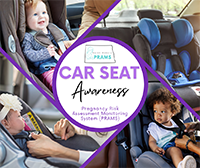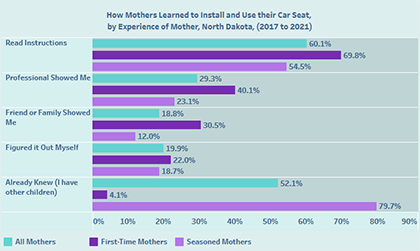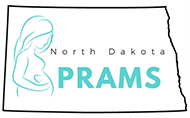Ask A Researcher
December 2023
Strapped for Safety: Exploring Insights into Car Seat Knowledge Among North Dakota Mothers
Samuel Faraday Saidu and Chelsey Hukriede

Samuel Faraday Saidu is a student at North Dakota State University, pursuing a master’s degree in public health with a specialization in Epidemiology and a sub-plan in maternal and child health. He currently works as a Graduate Research Assistant at the Center for Social Research (CSR). Samuel holds a bachelor’s degree in public health with an emphasis on Health Education and Promotion from Brigham Young University-Idaho.
Chelsey Hukriede is a research specialist with the CSR, providing support to various projects. She is also the Project Coordinator for North Dakota PRAMS, SOARS, and the Fatherhood Experiences Survey. Chelsey received her master’s degree in Sociology from the University of North Dakota.
The North Dakota Pregnancy Risk Assessment Monitoring System (PRAMS) is a collaborative project of the Centers for Disease Control and Prevention (CDC), the North Dakota Department of Health and Human Services, and the Center for Social Research at North Dakota State University. PRAMS collects state-specific, population-based data on maternal attitudes and experiences before, during, and shortly after pregnancy. These data can be used to identify groups of women and infants at high risk for health problems, to monitor changes in health status, and to measure progress towards goals in improving the health of mothers and infants.
To help disseminate project results, a series of dashboards, PRAMS Points, are being released on a variety of topics. Released topics include: oral health, safe sleep, gestational diabetes, pre-existing diabetes, maternal adverse childhood experiences, postpartum depression, and now car seat awareness.
This article accompanies the newly released PRAMS Points Dashboard regarding car seat awareness among women who recently gave birth in North Dakota. The dashboard uses North Dakota PRAMS data gathered from 2017 through 2021 to examine the various methods women, who recently gave birth, learned to install and use their infant car seats. Dashboards such as this, contribute to the ongoing surveillance efforts that can identify populations at risk and help create and evaluate programming and policies to improve health outcomes for pregnant women, babies, and families in North Dakota.
Car Seat Awareness Background
Nationwide, motor vehicle traffic crashes are a leading cause of death in children under 14 years of age [1]. In 2021, a total of 863 children in the United States died as a passenger in motor vehicles; of these children, 308 were found to be unrestrained [1]. This equates to an average of 3 daily child fatalities in 2021 due to motor vehicle crashes in the United States [1]. The same year, an estimated 445 children sustained injuries as a result of traffic crashes [1]. Among the 50 states, North Dakota had the highest percentage of child traffic fatalities in 2021 at 5.9 percent; the national average of child traffic fatalities was 2.8 percent [1].
Effective use of car seats and booster seats is imperative to minimize the risk of fatalities and injuries in motor vehicle crashes. Parents and guardians play a pivotal role in minimizing these risks by ensuring infants and children are properly secured in car seats that are suitable for their age and size [2]. Research underscores the life-saving potential of proper car seat usage, with a 71 percent reduction in the risk of death for infants under 1 year of age and a 54 percent reduction for toddlers 1 to 4 years old [1].
Despite the proven safety benefits of car seats, misuse remains a significant issue. Research reveals that more than half of the car seats are not installed correctly (59 percent). Common errors include failing to use the top tether in forward-facing car seats and having car seats and harnesses that are too loose [3]. Raising awareness and providing proper education are essential steps to enhance child car seat safety [4].
To address this critical concern, child restraint laws have been implemented, which mandate that children riding in motor vehicles must be securely buckled into car seats, booster seats, or seat belts appropriate for their age, weight, and height [2]. High-visibility enforcement programs such as 'Click it or Ticket' have significantly enhanced the effectiveness of these laws. Additionally, education programs are available to assist parents in obtaining new car seats and learning how to correctly install and secure their children [2].
The CDC provides recommendations to ensure the proper installation and use of car seats. This includes reading the car seat instruction manual thoroughly, adhering to the manufacturer's guidelines, and having a certified technician inspect the car seat to ensure it is correctly installed—a service that is often provided free of charge. Furthermore, children should continue to use a car seat or booster seat until they meet the height and weight requirements for using a seat belt alone, as recommended by the CDC [2].
Data and Trends
A national study by the American Academy of Pediatrics found that many parents install and use their car seats incorrectly with nearly all parents (93 percent) making at least one critical error buckling their newborn in for the ride home from the hospital [5]. The most common error was buckling their baby in too loosely (68 percent), followed by low placement for the harness clip, which should be at armpit level (33 percent). The correct car seat fit is snugger and with a harness clip higher than most parents feel it should be. Adhering to these guidelines can prevent injuries related to forward momentum and will not allow the shoulder straps to splay outward, ejecting the child from their car seat [5].
In North Dakota, 99.1 percent of women who recently gave birth reported having an infant car seat for their new baby, according to PRAMS data collected from 2017 through 2021. Although most own a car seat, mothers learn how to install their infant car seat in a variety of ways – some methods may provide more precise and appropriate installation and restraint information than others. A ‘gold-standard’ installation involves reading the instruction manual and/or seeking help from a health or safety professional [6].
The PRAMS survey asked women who recently gave birth about ways they learned how to install and use their infant’s car seat. Responses could have included: read instructions, a professional showed me, a friend or family member showed me, figured it out independently, or already knew how to install the seat because they have other children.
Notably, PRAMS data collected from 2017 through 2021 indicated a stark difference between first-time mothers and seasoned mothers (mothers who have other children) in the methods utilized when learning to install and use the infant car seat. Overall, three in five North Dakota mothers (60 percent) read the instructions provided with their infant car seat. Among first-time mothers, 70 percent read the instructions. Among seasoned mothers, 80 percent reported they already knew how to install a car seat.

Learning Methods of Car Seat Installation and Use by Maternal Characteristics
The way mothers learn how to install and use an infant car seat can vary by maternal characteristics such as age, level of education, household income level, maternal race and ethnicity, Medicaid status, as well as geography (urban or rural). Understanding these variations is crucial for developing targeted interventions and education programs to ensure proper car seat installation and usage.
Findings from North Dakota PRAMS data collected from 2017 to 2021 revealed that how first-time mothers learned to install and use their infant car seat varied by maternal characteristics.
Gold-Standard of Learning How to Install and Use a Car Seat
First-Time Mothers who were most likely to read instructions were women who:
- Had a bachelor’s degree (77%)
- Lived in rural North Dakota (74%)
- Were 20 to 29 years old (72%)
- Were White (72%)
- Did not have their prenatal care paid for by Medicaid (72%).
First-Time Mothers who were most likely to have a professional show them were women who:
- Were of the other racial category (e.g., Black, Asian, multi-races) (53%)
- Had a master’s, doctorate, or professional degree (48%)
- Lived in urban areas of North Dakota (46%)
- Were age 30 and older (44%)
- Had household incomes of $85,001 or more (44%).
Other Ways Mothers Learned to Install and Use a Car Seat
First-Time Mothers who were most likely to have friends or family show them were women who:
- Were younger than 20 years old (56%)
- Had less than a high school diploma (56%)
- Had their prenatal care paid for by Medicaid (48%)
- Were American Indian (43%)
- Had household incomes of $28,000 or less (40%).
First-Time Mothers who were most likely to figure it out themselves were women who:
- Were Hispanic (35%)
- Were younger than 20 years old (32%)
- Had household incomes of $28,000 or less (28%)
- Had their prenatal care paid for by Medicaid (28%)
- Lived in rural North Dakota (26%).
Conclusion
Proper car seat installation is crucial for child safety during travel. Although it appears that most mothers have access to a car seat for their infant, there is room for improvement to ensure car seats are used correctly. Data insights from this dashboard can inform targeted education and awareness campaigns to enhance child car seat safety across North Dakota. Ultimately, the goal is to reduce child fatalities and injuries in motor vehicle crashes, making every car ride a safer experience for young passengers.
References
1. National Center for Statistics and Analysis. (2023, May). Children: 2021 data (Traffic Safety Facts. Report No. DOT HS 813 456). National Highway Traffic Safety Administration. https://crashstats.nhtsa.dot.gov/Api/Public/ViewPublication/813456
2. Centers for Disease Control and Prevention. (2022, October). Child passenger safety: Get the facts. https://www.cdc.gov/transportationsafety/child_passenger_safety/cps-factsheet.html
3. Safe Kids Worldwide. (2017, September). More than half of car seats are not installed correctly. https://www.safekids.org/post/more-half-car-seats-are-not-installed-correctly
4. Simon, M.R., Korošec, A., and Bilban, M. (2016, November). The influence of parental education and other socio-economic factors on child car seat use. Slovenian Journal of Public Health, 56(1), 55–64. https://doi.org/10.1515/sjph-2017-0008
5. Kling, J. (2014, November). Almost All Infant Car Seats Misused. Medscape Medical News. https://www.medscape.com/viewarticle/833213?0=reg=1
6. California Department of Public Health (2021, April). Car Seat Basics.
About PRAMS
More information about the PRAMS project and PRAMS data can be found at www.hhs.nd.gov/prams.
Explore the NEW PRAMS Points Dashboard today!

Other PRAMS POINTS
• Pregnancy and Oral Health (May 2021)
• Gestational Diabetes (July 2022)
• Babies Safe Sleep (August 2022)
• Preexisting Diabetes (December 2022)
• Maternal Adverse Childhood Experiences (August 2023)
• Postpartum Depression (October 2023)
Explore the PRAMS Points Data Visualizations page today!
